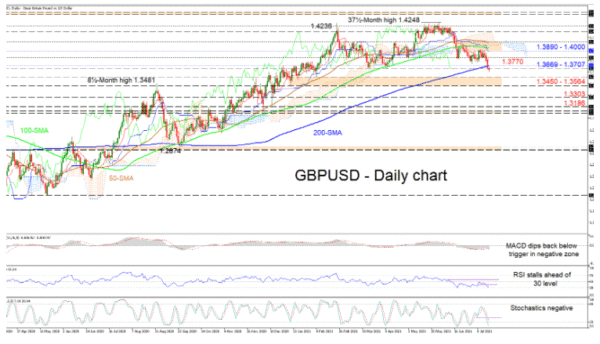GBPUSD has slipped underneath the 200-day simple moving average (SMA) at 1.3707 and the March and April troughs at 1.3669, strengthening a bearish notion as it surrenders extra ground. The dipping 50- and 100-day SMAs are giving the impression that bearish forces are seizing command.
The Ichimoku lines are indicating that downside risks are persisting, while the short-term oscillators are suggesting the pair may remain heavy for a little while longer. The MACD below zero has nudged back beneath its red trigger line, while the RSI is nearing the 30 level. Furthermore, the negatively charged stochastic oscillator is endorsing the reign of the bears.
If sellers manage to prolong the downward trajectory, initial deterrence to the descent could arise from the support zone of 1.3450-1.3564 formed between the lows of February 4 and January 11. Should this critical barricade fail to halt growing negative tendencies, the price may then sink to test the 1.3303 obstacle ahead of the 1.3186 trough.
If buyers manage to find their feet and successfully oppose accelerating bearish pressures, they would initially have to return above the 1.3669 level (previous support-now-resistance) and the nearby 200-day SMA at 1.3707. Pushing higher, the red Tenkan-sen line at 1.3770 and the neighbouring 1.3800 handle may attempt to negate the pair’s efforts to improve. Nonetheless, a more challenging resistance obstacle lingers overhead should buyers persist, that being an area from the blue Kijun-sen line at 1.3890 until the 1.4000 mark.
Summarizing, for GBPUSD’s recently adopted bearish bearing to remain active, the price would need to persist below the SMAs and the 1.3669 troughs. Yet, to elevate buyers’ confidence, the price would be required to pilot back above the SMAs and the Ichimoku cloud.













